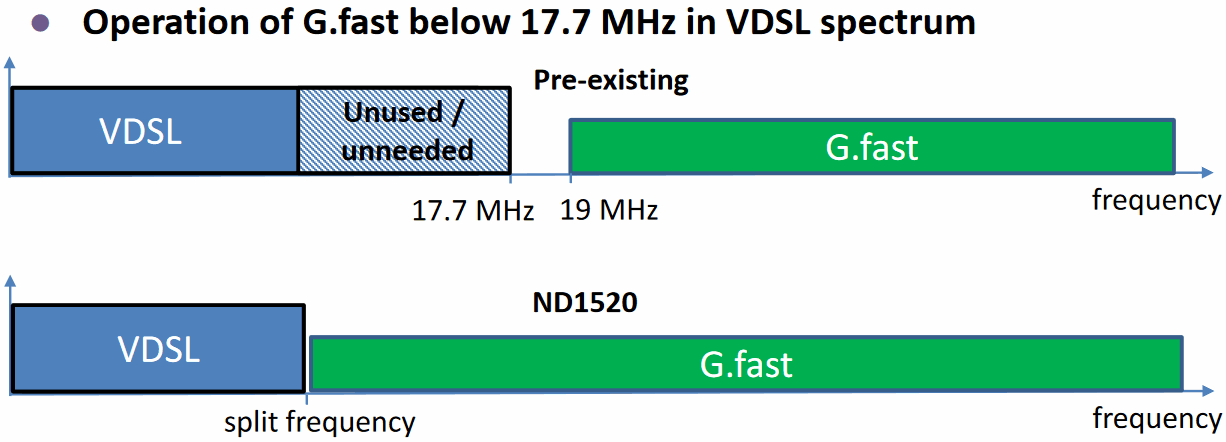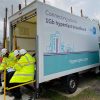Openreach UK Project Targets Speed Boost for G.fast Broadband
Openreach (BT) is slowly progressing with a future upgrade of their hybrid-fibre G.fast broadband technology, which could enable the service to harness some of the existing radio spectrum frequency being used by VDSL2 based Fibre-to-the-Cabinet (FTTC) lines. Early tests show a possible boost to speed and coverage.
The last time we reported on the possibility of spectrum sharing (refarming) between G.fast and VDSL2 was back in 2017 (here and here), when it was still just a concept. Since then further work has been done and BT have also updated their Access Network Frequency Plan (ANFP) to support it, plus the future 212MHz G.fast profile. Further related guideline changes for Digital Subscriber Line (DSL) transmissions are expected around September 2019.
At present both VDSL2 (uses 17.664MHz of spectrum and delivers speeds of up to 80Mbps) and G.fast (uses 19-106MHz for speeds of up to 330Mbps) keep their spectrum separate so as to avoid interference and also because they use two different forms of half / full duplexing (i.e. the transmission of data in two directions, either asymmetrically or symmetrically): VDSL2 uses Frequency Division Duplex (FDD) and G.fast harnesses Time Division Duplex (TDD).
Advertisement
Getting both technologies to co-exist in overlapping spectrum frequencies down to 2.2MHz is extremely difficult, particularly due to the risk of worse performance on existing VDSL2 lines (highly undesirable). However, if it were possible, then G.fast technologies could benefit from a fair improvement to speed and coverage (note: vectoring may be needed on VDSL2 and for technical / regulatory / cost reasons that’s not widely deployed).

One recent report on the work appears to suggest that it might just be possible for Openreach to achieve an “ultrafast broadband” speed of 100Mbps at 450-500 metres (copper line length) from the PCP street cabinet (G.fast extension pod) or remote node, which in the current deployment is NOT possible (speeds tend to fall below 100Mbps after around 300 metres).
However the potential gain to G.fast would only be up to 10Mbps if all they chose to do was reduce the technology’s start point from 19MHz to nearly 17.7MHz (i.e. trying to avoid any overlap with VDSL), which means to get the best boost they’d still need to overlap and that’s what this work is all about.
Advertisement
The work has been led by BT’s Kevin Foster, DSL Task Group Chairman, and receives input from UK ISPs including BT, TalkTalk, Vodafone and Sky Broadband. Meanwhile Ofcom, ASSIA, ECI, Huawei, Intel, Nokia and Sckipio have also given feedback to the team during their research.
The NICC recently published a public summary of Kevin’s work so far (here) and a technical report on the concept (here), which found three options (3, 4 and 5 below) that “offered attractive G.fast performance increases with varying complexities” (some of which do hurt VDSL performance).
NOTE: Frequencies below 2.2MHz are out of scope for this proposal (G.fast doesn’t use it).
Options Considered
1. No change to existing ANFP.
2. Static overlapping (REJECTED).
3. Re-farming; static re-assignment of high frequencies from VDSL to G.fast.Re-farming can scale from limited impact to large impact on VDSL with corresponding increases on G.fast speeds. The service coverage of existing un-vectored VDSL DSLAM may be maintained by vectoring the VDSL at the same time as enabling re-farming. It isn’t practical to define a single version of re-farming in the ANFP because the trade-offs will be heavily affected by DSL performance, product and services offerings and consensus between the DSLAM operator(s) and relevant Communications Providers (CPs).
Re-farming has the potential to provide significant improvements in G.fast rates and could be enabled within the ANFP subject to consensus between DSLAM operator(s) and relevant CPs. Re-farming could be combined with a Dynamic Spectrum Management (DSM) based control approach.
4. Variable split frequency (semi static); allow G.fast to use high frequencies on long loops unused by VDSL.
In co-located cases there is no gain for G.fast from the variable split frequency per DSLAM option, beyond that from reducing the start frequency to 17.7MHz. In non-co-located cases there is gain where Y is greater than about 700m, this gain is up to 113Mb/s. The option as presented requires knowledge of the loss between the G.fast and VDSL DSLAM, CGAL, and may require knowledge of whether the VDSL is vectored or not. A process would be required to manage recording and distribution of loss between DSLAMs and VDSL vectoring state.
5. Variable split frequency per line (dynamic).
DSM can offer improvements to downstream G.fast around 80 Mbps in co-located cases, and up to 164 Mbps in non-co-located cases relative to the current ANFP. DSM by its nature has considerable flexibility, but is not amenable to being defined by simple rules. A spectrum management centre would be required with interfaces to collect data from and configure DSLAMs.
The aforementioned technical report includes a wealth of simulations on the potential performance benefits of all this and the work is now continuing to develop a technical solution, which could form part of a future trial. So far Openreach has only run a very brief and limited Proof of Concept (PoC) test with 300 lines in All Hallows (Kent) via two street cabinets, which helped to inform the aforementioned report.
Advertisement
As usual any report that uses simulated modelling should be taken with a pinch of salt, not least because the real-world environment often has additional complications to consider (e.g. poor home wiring), which means that performance for some lines may be worse than the models.
In any case we’re probably still some way off from seeing a viable solution in the wild, assuming they can make one that works and delivers a strong improvement without harming VDSL2 lines. Admittedly all of this is somewhat of a sideshow to the now dominant focus on rolling out FTTP across the UK, with G.fast taking a diminished back seat position.
Mark is a professional technology writer, IT consultant and computer engineer from Dorset (England), he also founded ISPreview in 1999 and enjoys analysing the latest telecoms and broadband developments. Find me on X (Twitter), Mastodon, Facebook, BlueSky, Threads.net and Linkedin.
« After a Long Wait Cityfibre’s 1Gbps Full Fibre Goes Live in Cheltenham
ISP Commsworld Opens London Office Ahead of UK Fibre Launch »


















































Comments are closed